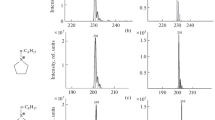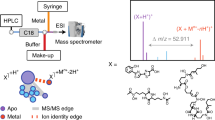Abstract
A series of 24 compounds of general formula R1S-Hg-SR2, R1 and R2 being biologically relevant thiol-containing amino acids and peptides (cysteine, homo-cysteine, penicillamine, N-acetyl-cysteine, N-acetyl-penicillamine, cysteinyl-glycine, γ-glutamyl-cysteine and glutathione) were prepared by direct reaction of mercury(II) ions and thiols in water at millimolar concentration. The obtained products were characterized by electrospray ionization and triple quadrupole tandem mass spectrometry. The source spectra of equimolar mixtures of two different thiols reacting with a stoichiometric amount of mercury(II) show the peak clusters of the three theoretically expected bis-thiolato-mercury(II) complexes with relative intensities close to the theoretically expected 1:2:1 ratio, thus pointing at lack of substantial discrimination between the different thiols, the only observed exception being homo-cysteine, which is less reactive than cysteine and penicillamine. The fragment spectra are structure-specific for the different ligands bound to the metal ion and allow a stand-alone discrimination of some constitutional isomer pairs. Among the peculiar fragmentation processes observed, loss of neutral ammonia from protonated symmetrical and unsymmetrical mercury(II)-bis-thiolates with free, protonizable amino groups leads to the formation of thiirane-carboxylic bound species; this process is suppressed when the protonated amino group is in the γ-position with respect to the sulfur atom, as in the case of compounds with homo-cysteine. This unusual behavior may hint at unforeseen mechanisms for the interaction of mercury(II) with biological structures, ultimately leading to cellular and organ toxicity. Compounds with N-acetylated amino acids show distinctive fragment ions to which the connectivity of a protonated 2-methyl-oxazoline-5-carboxylic acid may be proposed on the basis of the loss of water and of the elements of formic acid. Finally, the adducts of mercury(II) with glutathione and γ-glutamyl-cysteine feature a distinctive decomposition channel by loss of a pyroglutamic unit, much the same as protonated glutathione, glutathione disulfide, the S-glutathionyl adducts of biologically occurring electrophiles and other (pseudo)-peptides with γ-glutamyl bonds.
Similar content being viewed by others
References
Sirois, J. E.; Atchinson, W. D. Effect of Mercurials on Ligand- and Voltage-Gated Ion Channels: A Review. Neurotoxicology 1996, 17(1), 63–84.
Camerino, D.; Buratti, M.; Rubino, F. M.; Somaruga, C.; Bellugi, V.; Bordiga, A.; Bordini, L.; Maraschi, R.; Molinari, M.; Colosio, C.; Soleo, L.; Colombi, A. Valutazione degli effetti neurotossici e nefrotossici conseguenti all’esposizione a lungo termine a mercurio metallico dei lavoratori addetti agli impianti Cloro-Soda. [Evaluation of Long-Term Neurotoxic and Nephrotoxic Effects in Chloralkali Workers Exposed to Metallic Mercury, in Italian]. La Medicina del Lavoro 2002, 93(3), 238–250.
Zalups, R. K. Molecular Interactions with Mercury in the Kidney. Pharmacol. Rev. 2000, 52(1), 113–143.
Gelband, H. The Science and Politics of Dental Amalgam. Int. J. Technol. Assess. Health Care 1998, 14(1), 123–134.
Ramazzini, B. De Morbis Artificum Diatriba [On the Workers’ Diseases]: Chap. 2: [Goldsmiths’ diseases]; Chap 3: [On the Massagists’ Diseases]; Chap 7: [On the Glassmakers’ and Mirrormakers’ Diseases] (1713 Edition, Padua, Italy); italian translation: Le Malattie dei Lavoratori (Cosmacini, G.) Teknos (Roma, Italy) 1995 pp. 21,27,45
Mazzella Di Bosco, M.; Gremigni, D.; Raddi, R. Colesterolemia e lipoprotidogramma in 95 operai esposti al rischio di intossicazione cronica da mercurio [Cholesterol and Lipoproteins in 95 Mercury Exposed Workers, in Italian]. Lavoro Umano 1961, 13, 315–322.
Frustaci, A.; Magnavita, N.; Chimenti, C.; Caldarulo, M.; Sabbioni, E.; Pietra, R.; Cellini, C.; Possati, G. F.; Maseri, A. Marked Elevation of Myocardial Trace Elements in Idiopathic Dilated Cardiomiopathy Compared with Secundary Cardiac Dysfunction. J. Am. Coll. Cardiol. 1999, 33, 1578–1583.
Ballatori, N.; Clarckson, T. W. Inorganic Mercury Secretion into Bile as a Low MW Complex. Biochem. Pharmacol. 1984, 33(7), 1087–1092.
Wei, H.; Qiu, L.; Divine, K. K.; Ashbaugh, M. D.; McIntyre, L. C. Fernando, Q.; Gandolfi, A. J. Toxicity and Transport of Three Synthesized Mercury-Thiol-Complexes in Isolated Rabbit Renal Proximal Tubule Suspensions. Drug Chem. Toxicol. 1999, 22(2), 323–341.
Oram, P. D.; Fang, X.; Fernando, Q.; Letkeman, P.; Letkeman, D. The Formation Constants of Mercury(II)-Glutathione Complexes. Chem. Res. Toxicol. 1996, 9(4), 709–712.
Fuhr, B. J.; Rabenstein, D. L. Nuclear Magnetic Resonance Studies of the Solution Chemistry of Metal Complexes. IX. The Binding of Cadmium, Zinc, Lead, and Mercury to Glutathione. J. Am. Chem. Soc. 1973, 95(21), 6944–6950.
Taylor, N. J.; Carty, A. J. Nature of Mercury2+ Ion l-Cysteine Complexes Implicated in Mercury Biochemistry. J. Am. Chem. Soc. 1997, 99(18), 6143–6145.
D’Agostino, A.; Colton, R.; Traeger, J. C.; Canty, A. J. An Electrospray Mass Spectrometric Study of Organomercury(II) and Mercuric Interactions with Peptides Involving Cysteinyl Ligands. Eur. J. Mass Spectrom. 1996, 2, 273–285.
Canty, A. J.; Colton, R.; D’Agostino, A. P.; Traeger, J. C. A Positive and Negative Ion Electrospray Mass Spectrometric Studies of Some Amino Acids and Glutathione, and Their Interactions with Alkali Metal Ions and Methylmercury(II). Inorg Chim. Acta 1994, 223, 103–107.
Garzotti, M.; Rovatti, L.; Hamdan, M. Investigation of Bombolithin Complexes with Mercury by Liquid Chromatography-Tandem Mass Spectrometry. Rapid Commun. Mass Spectrom. 1998, 12, 61–68.
Boysen, R. I.; Hearn, M. T. W. Direct Characterization by Electrospray Ionization Mass Spectrometry of Mercuro-Polypeptide Complexes After Deprotection of Acetamidomethyl Groups from Protected Cysteine Residues of Synthetic Polypeptides. J. Biochem. Biophys. Methods 2000, 45(2), 157–168.
Harrington, C. F.; Romeril, J.; Catterick, T. The Speciation of Mercury and Organomercury Compounds by High Performance Liquid Chromatography-Atmospheric Pressure Ionization Mass Spectrometry. Rapid Commun. Mass Spectrom. 1998, 12, 911–916.
Mehra, R. K.; Miclat, J.; Kodati, V. R.; Abdullah, R.; Hunter, T. C.; Mulchandani, P. Optical Spectroscopic and Reverse-Phase HPLC Analyses of Hg(II) Binding to Phytochelatins. Biochem. J. 1996, 314(Pt 1), 73–82.
Yen, T. -Y.; Villa, J. A.; DeWitt, J. G. Analysis of phytochelatin-Cd complexes from plant tissue culture using nano-electrospray ionization tandem MS and capillary LC-ESI tandem MS. J. Mass Spectrom. 1999, 34, 930–941.
Büdi, B.; Sengupta, S.; DiBello, P. M.; Kinter, M. T.; Jacobsen, D. W. A Facile Synthesis of Homocysteine-Cysteine Mixed Disulfide. Anal. Biochem. 2001, 291, 303–305.
Bernareggi, A.; Torti, L.; Maffei, F. R.; Carini, M.; Depta, G.; Casetta, B.; Farrell, N.; Spadacini, S.; Ceserani, R.; Tognella, S. Characterization of Cisplatin-Glutathione Adducts by Liquid Chromatography-Mass Spectrometry. Evidence for Their Formation in Vitro but Not in Vivo After Concomitant Administration of Cisplatin and Glutathione to Rats and Cancer Patients. J. Chromatogr. B 1995, 669, 247–263.
Singh, R.; Silvia Elipe, M. V.; Pearson, P. G.; Arison, B. H.; Wong, B. K.; White, R.; Yu, X.; Burgey, C. S.; Lin, J. H.; Baillie, T. A. Metabolic Activation of a Pyrazinone-Containing Thrombin Inhibitor. Evidence for Novel Biotransformation Involving Pyrazinone Ring Oxidation, Rearrangement, and Covalent Binding to Proteins. Chem. Res. Toxicol. 2003, 16, 198–207.
Han, I. -S.; Kim, C. K.; Lee, B. -S.; Lee, I. Ab Initio Studies of Three-Membered Ring Formation Through Intramolecular Nucleophilic Substitution. J. Comp. Chem. 1997, 18, 1773–1784.
Zoller, U. Three Membered Rings Containing Sulfur. IV. Thiironium Derivatives (Episulfonium Ions). In The Chemistry of Heterocyclic Compounds. Weissberger, A., Taylor, E. C., Eds.; Small Ring Heterocycles, Part 1. Aziridines, Azirines, Thiiranes, Thiirenes. (Hassner, A., Ed.) Wiley: New York, 1983; pp 450–474.
Byrne, M. P.; Broomfield, C. A.; Stites, W. E. Mustard Gas Crosslinking of Proteins Through Preferential Alkylation of Cysteines. J. Protein Chem. 1996, 15, 131–136.
Broch, H.; Hamza, A.; Vasilescu, D. Quantum Molecular Modeling of the Interaction Between Guanine and Alkylating Agents 1. Sulfur Mustard. J. Biomol. Struct. Dyn. 1996, 13, 903–914.
Author information
Authors and Affiliations
Corresponding author
Additional information
Published online January 23, 2004
Rights and permissions
About this article
Cite this article
Rubino, F.M., Verduci, C., Giampiccolo, R. et al. Molecular characterization of homo- and heterodimeric mercury(II)-bis-thiolates of some biologically relevant thiols by electrospray ionization and triple quadrupole tandem mass spectrometry. J Am Soc Mass Spectrom 15, 288–300 (2004). https://doi.org/10.1016/j.jasms.2003.10.013
Received:
Revised:
Accepted:
Issue Date:
DOI: https://doi.org/10.1016/j.jasms.2003.10.013




